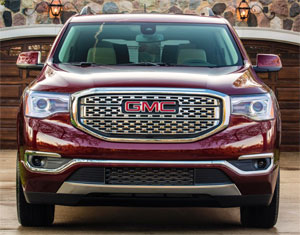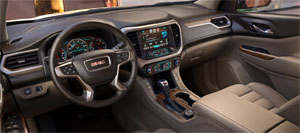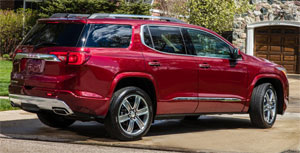2017 GMC Acadia
One constant you can put up there with death and taxes, is people always want more. So, it’s usually the case for each new generation of vehicle to get bigger and bigger. Well, GM has proved before they’re not afraid to give people more from less, and that’s the story behind this new GMC Acadia, so let’s hear more about it.
Trivia question: what was the first modern 3-row crossover? If you said the 2007 Saturn Outlook, congratulate yourself. If you said the 07’ GMC Acadia; well, you’re half right as it did share its chassis with the Outlook. And if you’re saying “what is a Saturn?” Well, you’ll have to google it, as we must move on and start talking about this 2017 GMC Acadia.
Trim is in, and no one has been on more of a weight-loss kick than General Motors. Now sharing a chassis with the Cadillac XT5, its 700-lbs. lighter than the outgoing Acadia. That’s due to a shrunken exterior size, more high strength steel, and a smaller 193-horsepower 2.5-liter I4 engine that is now standard. But, even with the V6, it’s some 600-lbs. lighter.
 That 3.6-liter V6 is now optional and it’s also a new one, putting out both more horsepower at 310, and more torque at 271 lb-ft. Yet despite the bigger numbers, towing capacity falls from 5,200-lbs to 4,000, mostly due to the tidier dimensions.
That 3.6-liter V6 is now optional and it’s also a new one, putting out both more horsepower at 310, and more torque at 271 lb-ft. Yet despite the bigger numbers, towing capacity falls from 5,200-lbs to 4,000, mostly due to the tidier dimensions.
With overall length cut 7–inches, and wheelbase shaved by over 6-inches, the new Acadia is far more garage-able. So, it’s now more midsize than full-size, looking very Dodge Durango-ish, and directly competitive with the Honda Pilot and Toyota Highlander.
Trimmer also helps the exterior appearance, now more modern and stylish; and, thankfully, far from a mini-me Yukon. Signature LEDs are standard on all models.
Denali trim still features an overdose of chrome, and a big grille for fully flaunting it.
Both engines come with a 6–speed automatic transmission, with a choice of front or all-wheel-drive.
Our V6 all-wheel-drive tester showed a noticeable lack of torque down low; but once you reach 4,000 on the dial, a surprising surge of power gets delivered rather abruptly. We hit 60 in 6.8-seconds; pretty quick for a 3-row family ute, and over a second quicker than before. We finished out the ¼ in 15.4-seconds at 92 miles-per-hour.
 Shifting of the automatic transmission was very slow, with a noticeable lack of momentum each time a new gear was selected. With a short 119-foot stopping average from 60, and only minimal fade; the brakes were very confidence inspiring.
Shifting of the automatic transmission was very slow, with a noticeable lack of momentum each time a new gear was selected. With a short 119-foot stopping average from 60, and only minimal fade; the brakes were very confidence inspiring.
And if you zone out and need the Acadia to apply the brakes for you, it can do that as well, abruptly and consistently; provided you opt to add the Technology Package.
The optional all-wheel-drive system operates as front only if you chose, or leave it in auto. You can also select Sport, Off Road, and Trailer Tow modes.
Of course, the smaller size has taken a toll on interior space. But, you won’t really notice it much in first or second row seating. The 2nd row split bench, or Captain’s chairs, all slide fore and aft, as well as fold easily.
The third row is actually easier to get to, but noticeably tighter when you do. And, seatbelts are down from three to two. So, Acadia’s max body count drops from 8 to 7.
Maximum cargo capacity falls most of all, from 116.1 cubic-ft. to 79.0. Still all these aspects are competitive with Pilot and Highlander.
 As for how it drives, well lighter is always righter; so it certainly feels more agile. But we’d avoid the I4 unless you’re a lone wolf.
As for how it drives, well lighter is always righter; so it certainly feels more agile. But we’d avoid the I4 unless you’re a lone wolf.
V6 Government Fuel Economy Ratings with all-wheel drive are respectable, at 18-City, 25-Highway, and 20-Combined. We averaged a good 22.1 miles-per-gallon of Regular. For a reasonable Energy Impact Score of 16.5-barrels of oil burned yearly, while emitting 7.2-tons of CO2.
Base pricing is $1,905 lower than before, starting at $29,995. But again, that’s for the I4 and you’re going to want the V6 that will cost you at least $37,090. AWD adds 2-grand more; Acadia Denali starts at $45,845.
The 2017 GMC Acadia is clearly better in every aspect including size. While nothing about the Acadia blew us away with excitement, there’s a lot to like about it.
Yes, the smaller size means Acadia has given up its niche of being a true full-size truckin’ SUV alternative. And, only time will tell if the “going along to get along” strategy will work. But, for now, we think the Acadia will deliver more, from less, for more of you.
Specifications
- Engine: 3.6 liter
- Horsepower: 310
- Torque: 271 lb-ft.
- 0-60 mph: 6.8 seconds
- 1/4 mile: 15.4 seconds @ 92 mph
- EPA: 18 mpg city / 25 mpg highway
- Energy Impact: 16.5 barrels of oil/yr
- CO2 Emissions: 7.2 tons/yr
2025 Volkswagen ID. Buzz
Volkswagen Brings Beetlemania Level Of Excitement To Minivan Segment
The duty of upholding Volkswagen’s heritage has most recently been delegated to small legacy car names like Golf and Jetta. But hold on! A much larger, totally modern take on VW’s classic microbus has just buzzed over the horizon— the all-electric ID. Buzz. It’s been at the top of our minds since we first saw the concept back in 2017. Well, it’s finally here, so let’s get our groove into drive!
This 2025 Volkswagen ID. Buzz has indeed created the most buzz around Volkswagen since the Beetle’s return to the U.S. in the late 1990s. We couldn’t drive it anywhere without drawing a crowd. No wonder, just about everyone has a VW Microbus story to tell, and seeing this reimagined version rolling down the street brings back all those memories.
VW really pulled it off as far as we’re concerned, as it looks great without appearing over the top. All the cues are here: Big VW logo front and center, lots of greenhouse including A-pillar windows and mini sliders for the second-row passengers, D-pillar air vents, and two-tone wheels. And while its appearance may be pure retro, its drivetrain is far from it, as the ID. Buzz is all-electric, and unlike the new Beetle, the Buzz does retain the original Microbus’ rear-drive architecture.
Powering those rear wheels is a 210-kW motor drawing juice from a 91-kWh battery for a range of 234 miles; 200-kW max charging will get you to 80% in about 26 minutes. Buyers can add another small 80-kW motor up front for 4motion all-wheel-drive and an increase of total output from 282 to 335 horsepower with a combined 512 lb-ft of torque. It uses the same battery, but range estimates drop just slightly to 231 miles. But while those numbers are modest, we also found them to be quite conservative, as we observed as many as 287 miles available in our all-wheel-drive tester’s gauge display and were on pace for 273 miles in our driving loop.
One throwback theme that may be a turnoff to some is that it’s quite a step up into the Buzz’s front seats, but there’s certainly a commanding view of the road once you climb in. Second row seating can be either a three-place bench or a pair of captain’s chairs, so there’s generous room for seven or six passengers. The captain’s chairs in our Pro S Plus offer good support and very easy access to the third row.
Lots of flexibility too with the option to simply fold the seats or remove them altogether.
With the sliding side doors and a wide opening rear hatch, there’s plenty of access for loading big sport utility amounts of cargo. Lots of flexibility too with the option to simply fold the seats or remove them altogether, and the ability to create a full-length flat floor with a rear cargo shelf that covers some handy removable storage bins. There’s 18.6 cubic-feet of space behind the third row, 75.5 behind the second, and a max of 145.5. That’s more than a Chevrolet Tahoe. For smaller items, there are lots of cubbies throughout the cabin, along with a standard Buzz Box that can be moved to multiple locations.
With a design that prioritizes retro form and modern function over aero efficiency, the 4motion equipped ID. Buzz earns a Fair efficiency rating, using 42-kWh of electricity per 100 miles, and we weren’t sure what to expect at our Mason Dixon test track.
What we found was great torque off the line and drama free launches to 60 in just 5.3 seconds. It was very stable at speed and power delivery stayed steady most of the way down the track until we reached about 90 mph, when it began to taper off just before we finished the quarter-mile in 14.0 seconds flat at 97 mph.
With 1,200-lbs. of battery weight nestled in its 127.5-inch wheelbase, the Buzz felt planted to the pavement through our handling course. There was quite a bit of body roll to deal with, but surprisingly little understeer. In panic braking runs, pedal response was inconsistent, feeling soft at times, pushing back hard at others; but through it all, results were quite good, stopping from 60 in an average of just 108 feet.
Three interior themes are available, this Dune is the brightest, featuring coastal inspired wood optic dash décor, “gray and clay” leatherette surfaces, and a high-mounted central 12.9-inch touchscreen. Pricing starts with a rear-wheel-drive Pro S at $61,545; this Pro S Plus begins at $65,045, add another $4,500 for 4motion, which brings a few extra features along with all-wheel drive.
Retro design with old-school VW charm, modern EV drivetrain, big SUV capacity merged with minivan flexibility; it all comes together in this 2025 Volkswagen ID. Buzz. It’s easily one of the coolest rides of the year and one that will likely keep Volkswagen dealers buzzing for years to come, and that’s something no other people and things mover can say.
Specifications
As Tested
- Motor Setup: Dual-Motor AWD
- Battery Size: 91-kWh
- Horsepower: 335
- Torque: 512 lb-ft
- EPA Range: 231 miles
- 0-60 mph: 5.3 seconds
- 1/4 Mile: 14.0 seconds at 97 mph
- Braking, 60-0: 108 feet
- MW Test Loop: ~ 273 miles













































